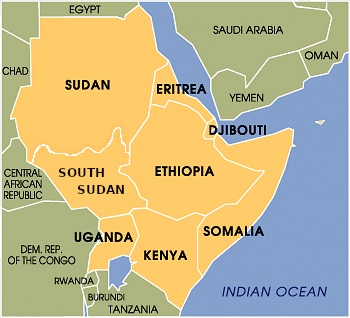
While countries of the horn of African region are redoubling efforts to mitigate the impacts of climate change, some of the natural phenomena occurring in the region rather call for even more concerted efforts to tackle them.
For instance a recent study published in Nature journal indicates that the region has reached a tipping point in 11700 years ago. “We found that, during the last ice age between 75,000 and 11,700 years ago, higher temperatures in the Horn of Africa did indeed produce a wetter climate,” Verschuren explains. “But around 11,700 years ago, when the region’s temperature naturally rose by a few degrees, we saw a tipping point in which higher temperatures led to increased drought, and lower temperatures meant wetter conditions.”
This fundamental change in the relationship between temperature and moisture in the Horn of Africa has since locked this region into a dry tropical climate regime, which the researchers expect to continue as temperatures keep rising in the future.
“This finding matches with the increasing number and severity of droughts we now see happening in the Horn of Africa,” Baxter illustrates. Quite importantly for this region where most people depend on rain-fed agriculture, the new research suggests that the Horn of Africa is likely to become even drier, not wetter in the future as predicted by most climate models.
“Though it’s still debated what the cause is of these recent droughts, our research provides the clue to an underlying mechanism. Our data has revealed certain processes that we hope are better incorporated in the climate models to more accurately predict long-term future climate change in this and other tropical regions.”
A recent climate forecast by the horn of African body, IGAD also supports the claims that the region will experience wetter season. According to a press release from IGAD Climate Prediction and Applications Centre (ICPAC) the October to December 2023 climate forecast shows high chances of wetter-than-usual conditions across most parts of the Greater Horn of Africa. ICPAC warns that there could be an exceptionally high probability (>80%) of experiencing wetter-than-usual rainfall in southern Ethiopia, eastern Kenya, and southern Somalia. On the other hand, probabilities indicate drier-than-usual conditions for isolated areas of south-western Uganda and south-western South Sudan.
As a result of the heavy rainfall experienced across much of the region from March to May (MAM) 2023, increased precipitation from October to December (OND) 2023 may contribute to flooding. Dr Guleid Artan, ICPAC Director, noted: “We have now entered El Niño conditions which, for Eastern Africa, are synonymous with wetter conditions during OND.
After three years of devastating drought, this may be seen as a blessing for farmers. Still, it can quickly become a curse. Desert locusts are already proliferating to alarming levels in parts of the region*. The risk of deadly incidents also increases significantly. We all remember the last El Niño in 2015/16 when downpours of torrential rains caused landslides, flash floods, and buildings to collapse. Governments and disaster management agencies are advised to take all necessary measures to save lives and livelihoods.”
Dr Hussen Seid, Climate Modelling Expert at ICPAC, added: “El Niño is a climate phenomenon characterised by the periodic warming of sea surface temperatures in the central and eastern equatorial Pacific Ocean. Its effects can influence weather patterns worldwide. Another significant phenomenon known as the Indian Ocean Dipole is developing over the Indian Ocean and will reinforce the El Niño impacts.”
October to December constitutes a vital rainfall season, particularly in the equatorial parts of the Greater Horn of Africa, contributing 20-70% of the annual total rainfall. The start of the season will likely occur early in parts of the region where elevated rainfall is anticipated (eastern Kenya, southern Somalia, and eastern Tanzania). In contrast, probabilities favour an average or delayed onset over parts of northern Somalia, western Kenya, Uganda, southern South Sudan, Rwanda, Burundi, and north-western Tanzania.
An SPI analysis of predicted precipitation for October to December 2023 indicates the potential for moderate to severe wet conditions over southern Ethiopia, eastern Kenya, and southern Somalia and moderately wet conditions over other regions with a higher probability of above-normal totals (Figure 2). As a result of the observed above_average rainfall experienced across much of the Greater Horn of Africa during March to May 2023 (MAM 2023), elevated rainfall during October to December 2023 (OND 2023), as favoured by the forecast, may potentially contribute to flooding in areas prone to floods.
The predicted start dates of the October to December 2023 rainfall season based on 3 Global Climate Model forecasts are provided in Figure 3. Over eastern Kenya and southern Somalia, where probabilities of above-normal seasonal totals are highest, and over parts of eastern Tanzania, analysis of daily predicted rainfall indicates a raised chance of early onset. In contrast, probabilities favour a normal or delayed start to the season over parts of northern Somalia, western Kenya, Uganda, southern South Sudan, Rwanda, Burundi, and north-western Tanzania. In most of these regions, above-normal seasonal totals are also favoured (Fig. 1) but with lower probability.
Identifying historical years when the main global climate influences on GHA rainfall were similar to those expected this year (an analogue year analysis) can aid in understanding the forecast. This is especially pertinent this year due to the notably elevated likelihood of above-average rainfall, mostly in the eastern parts of the region. An analogue year analysis based on the present and predicted evolution of the Nino3.4 and IOD indices indicate that 1997 and 2006 are the closest matches to 2023 (as shown in Figure 4). Analysing the observed rainfall patterns between 1997 and 2006 shows wetter-than-normal conditions across most of the GHA.
The consolidated objective temperature forecast (Figure 5) from 9 Global Producing Centres (GPCs) indicates an increased likelihood of warmer-than average surface temperatures for almost all parts of the GHA. Probabilities of warmer than average temperatures are most enhanced over Djibouti, Eritrea, northern Ethiopia, northern Somalia, and parts of coastal Tanzania. In contrast, over certain isolated parts of eastern Kenya and the bordering areas between Kenya and Somalia, probabilities favour cooler-than-normal conditions. These latter areas are within the region with the highest probabilities for above-normal rainfall.
BY STAFF REPORTER
THE ETHIOPIAN HERALD WEDNESDAY 23 AUGUST 2023





